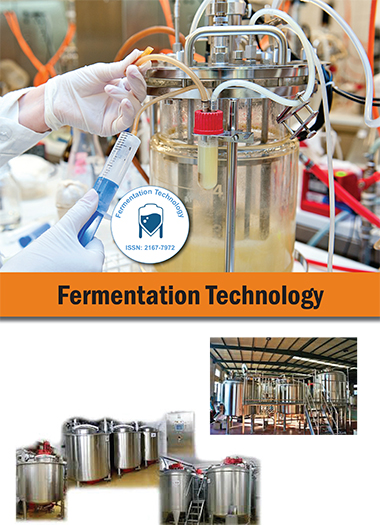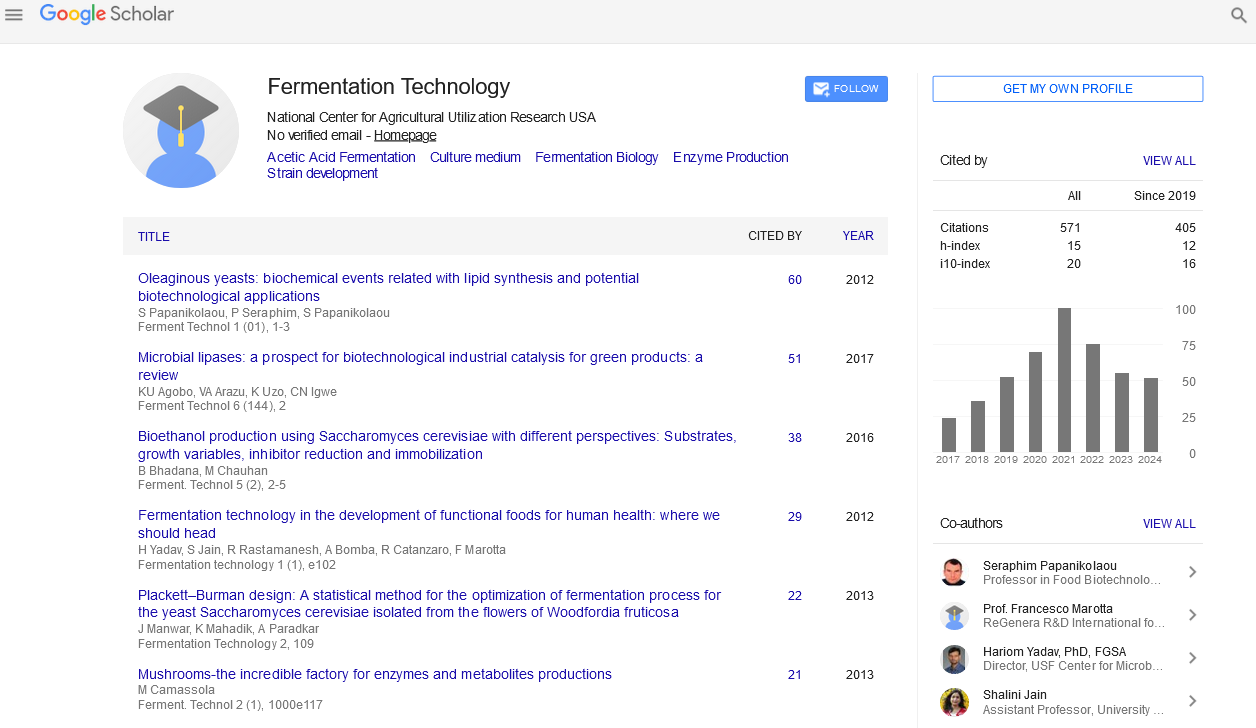Indexed In
- Open J Gate
- Genamics JournalSeek
- Access to Global Online Research in Agriculture (AGORA)
- RefSeek
- Hamdard University
- EBSCO A-Z
- OCLC- WorldCat
- Publons
Useful Links
Share This Page
Journal Flyer

Open Access Journals
- Agri and Aquaculture
- Biochemistry
- Bioinformatics & Systems Biology
- Business & Management
- Chemistry
- Clinical Sciences
- Engineering
- Food & Nutrition
- General Science
- Genetics & Molecular Biology
- Immunology & Microbiology
- Medical Sciences
- Neuroscience & Psychology
- Nursing & Health Care
- Pharmaceutical Sciences
Short Communication - (2025) Volume 14, Issue 1
Synthetic Biology Approaches in Fermentation Technology: Redesigning Microbes for Next-Generation Bio-Manufacturing
Daniel Paul*Received: 26-Feb-2025, Manuscript No. FMT-25-29076; Editor assigned: 28-Feb-2025, Pre QC No. FMT-25-29076 (PQ); Reviewed: 13-Mar-2025, QC No. FMT-25-29076; Revised: 20-Mar-2025, Manuscript No. FMT-25-29076 (R); Published: 27-Mar-2025, DOI: 10.35248/2167-7972.25.14.186
Description
Fermentation has long served as a foundation for producing food, pharmaceuticals, fuels and industrial chemicals. With the rise of synthetic biology, the boundaries of fermentation have expanded beyond traditional methods, enabling precise control over microbial function. By designing or reprogramming microbial systems at the genetic level, synthetic biology transforms fermentation into a more predictable and efficient tool for bio-manufacturing.
Defining synthetic biology in fermentation
Synthetic biology integrates principles from engineering, molecular biology and computer science to create novel biological systems or redesign existing ones. In fermentation, this involves the construction of customized genetic circuits, optimized metabolic pathways and chassis organisms tailored for specific production goals [1-3].
Unlike classical strain improvement, which often relies on random mutagenesis or adaptive evolution, synthetic biology offers targeted, modular and reproducible solutions.
Chassis organisms for synthetic fermentation
A chassis organism is a host microbe engineered to perform specific biosynthetic tasks. Commonly used chassis in fermentation include:
- Escherichia coli: Fast growth, well-characterized genetics and compatibility with synthetic circuits.
- Saccharomyces cerevisiae: Preferred for ethanol and pharmaceutical production due to its GRAS (Generally Recognized as Safe) status.
- Corynebacterium glutamicum: Known for amino acid production and high tolerance to toxic compounds.
- Bacillus subtilis: Efficient secretion systems, making it ideal for enzyme production.
Each chassis is optimized for performance through genome streamlining, removal of unnecessary genes and integration of synthetic pathways.
Designing synthetic pathways
Synthetic biology enables the construction of biosynthetic routes that do not naturally exist in the host. For example, microbes have been engineered to convert sugars into complex molecules like artemisinin (an antimalarial drug), biodegradable plastics, or fragrances [4-6].
Key design considerations include:
- Pathway balancing: Controlling enzyme levels to match intermediate flux.
- Gene regulation: Using synthetic promoters, ribosome binding sites and transcription factors to fine-tune gene expression.
- Metabolite channeling: Spatial organization of enzymes to improve efficiency and reduce by-product formation.
Tools such as CRISPR, Golden Gate assembly and DNA synthesis platforms accelerate the Design-Build-Test-Learn (DBTL) cycle in synthetic fermentation [7].
Genome editing and regulation
Advanced genome editing tools, particularly CRISPR-Cas systems, enable precise modifications of microbial genomes. This allows deletion of competing pathways, insertion of entire biosynthetic clusters and control of native metabolism.
Inducible promoters and synthetic switches respond to specific environmental signals or metabolic states, enabling dynamic regulation of production. These systems improve productivity while reducing metabolic burden during growth phases [8].
Applications in industrial fermentation
Biofuels: Engineering yeasts and bacteria to produce ethanol, butanol, or biodiesel precursors from non-traditional feedstocks like lignocellulosic biomass or industrial gases.
Bioplastics: Microbes programmed to synthesize Polyhydroxyalkanoates (PHAs), polylactic acid precursors, or novel monomers for biodegradable materials.
Fine chemicals: Production of natural and non-natural compounds, including flavors, fragrances, colorants and pharmaceuticals.
Protein therapeutics: Engineered microbes capable of producing insulin analogs, growth factors, or monoclonal antibodies with humanized modifications.
Biosensors and process control
Synthetic biology introduces biosensors that detect internal or external signals (e.g., metabolite levels, pH, oxygen) and adjust gene expression accordingly. These feedback systems allow microbes to self-optimize production, improving yield and reducing costs [9, 10].
Biosensors can also be integrated with fermentation monitoring systems to trigger automatic interventions, such as nutrient feeding or pathway activation.
Challenges and safety considerations
Despite its potential, synthetic biology in fermentation faces several hurdles:
- Genetic instability: Synthetic constructs may be lost or mutated over time, especially in high-density cultures.
- Metabolic burden: Overexpression of synthetic pathways can divert resources from cell growth and reduce fitness.
- Regulatory barriers: Approval of Genetically Modified Organisms (GMOs) for industrial use varies by region and application.
- Containment: Preventing escape and horizontal gene transfer is essential for environmental safety.
To address these concerns, biological containment strategies (e.g., kill-switches, auxotrophy) and DNA watermarking are being developed to enhance biosafety.
Conclusion
Synthetic biology is redefining fermentation as a customizable, precise and scalable tool for modern bio-manufacturing. By combining genetic design, automation and systems-level understanding, microbes can now be programmed to produce a wide array of products with improved efficiency. While challenges remain, the continued integration of synthetic biology into fermentation holds great potential to support a sustainable, bio-based economy.
References
- Onipe OO, Jideani AI, Beswa D. Composition and functionality of wheat bran and its application in some cereal food products. Int. J. Food Sci. 2015;50(12):2509-2518.
- Cheirsilp B, Radchabut S. Use of whey lactose from dairy industry for economical kefiran production by Lactobacillus kefiranofaciens in mixed cultures with yeasts. N Biotechnol. 2011;28(6):574-580.
[Crossref] [Google Scholar] [PubMed]
- Church FC, Porter DH, Catignani GL, Swaisgood HE. An o-phthalaldehyde spectrophotometric assay for proteinases. Anal Biochem. 1985;146(2):343-348.
[Crossref] [Google Scholar] [PubMed]
- Coda R, Rizzello CG, Pinto D, Gobbetti M. Selected lactic acid bacteria synthesize antioxidant peptides during sourdough fermentation of cereal flours. Appl Environ Microbiol. 2012;78(4):1087-1096.
[Crossref] [Google Scholar] [PubMed]
- Dubois M, Gilles K, Hamilton JK, Rebers PA, Smith F. Colorimetric determination of reducing and nonreducing saccharides. Nature. 1951;168:167-169.
[Crossref] [Google Scholar] [PubMed]
- Singleton VL, Orthofer R, Lamuela-Raventós RM. Analysis of total phenols and other oxidation substrates and antioxidants by means of folin-ciocalteu reagent. Meth. Enzymol 1999;299:152-178.
- Jung UJ, Lee MK, Park YB, Jeon SM, Choi MS. Antihyperglycemic and antioxidant properties of caffeic acid in db/db mice. J Pharmacol Exp Ther. 2006;318(2):476-483.
[Crossref] [Google Scholar] [PubMed]
- Mateo Anson N, Aura AM, Selinheimo E, Mattila I, Poutanen K, Van Den Berg R, et.al. Bioprocessing of wheat bran in whole wheat bread increases the bioavailability of phenolic acids in men and exerts antiinflammatory effects ex vivo. J Nutr. 2011;141(1):137-143.
[Crossref] [Google Scholar] [PubMed]
- Pham PL, Dupont I, Roy D, Lapointe G, Cerning J. Production of exopolysaccharide by Lactobacillus rhamnosus R and analysis of its enzymatic degradation during prolonged fermentation. Appl Environ Microbiol. 2000;66(6):2302-2310.
[Crossref] [Google Scholar] [PubMed]
- Russo P, de Chiara MLV, Capozzi V, Arena MP. Lactobacillus plantarum strains for multifunctional oat-based foods. LWT - Food Sci. Technol. 2016; 68:288-294.
Citation: Paul D (2025). Synthetic Biology Approaches in Fermentation Technology: Redesigning Microbes for Next-Generation Bio-Manufacturing. Ferment Technol. 14:186.
Copyright: © 2025 Paul D. This is an open-access article distributed under the terms of the Creative Commons Attribution License, which permits unrestricted use, distribution and reproduction in any medium, provided the original author and source are credited.

